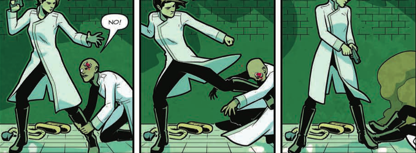G.I. Joe #10 // Review
Science isn’t pretty. Evil science in pulpy sci-fi can get pretty ugly. Writer Paul Allor finds a humanity behind the creepiness of mad science in G.I. Joe #10. Allor’s darkness stylishly fuses to the page courtesy of artist Chris Evenhuis. The shiny glow punctuating the darkness is given a cool presence thanks to the work of colorist Brittany Peer. Once again, Allor finds a way to bring a single story to the page that feels strikingly complete even though it only takes 20 pages to begin and end. The tenth journey into a world ruled over by the evil Cobra feels like one of Allor’s best.
There have been advancements in automated soldier technology. The dream of having perfectly mindless drones that are totally capable on a battlefield gets one step closer as Dr. Mindbender has been given the opportunity to plant the brains of soldiers directly into combat androids. A couple of G.I. Joe operatives wait outside the facility. They don’t know the full reality of what’s going on inside the facility, but they wouldn’t be there if they didn’t have a plan that involved being inside. What with the technology being what it is, however, spies from the outside are the least of Mindbender’s problems.
Over the course of the series thus far, Allor has shown a willingness to show the complexities of human conflict that go well beyond the black-and-white good-vs.-evil paradigm that dominated the property at the time of its birth in the 1980s. Allor gives Mindbender just enough depth to provide a glimpse into the ambitions of a man who might have been great if he could have pointed himself in a less sociopathic direction. The concerns of a newly-awakened cyborg show a degree of complexity as well. He even manages a reasonably complicated look into the life of a Joe agent who is forced to confront the injustices she’s been forced to allow in the pursuit of justice.
It’s refreshing to see Evenhuis back at work on the series. The clean-lined simplicity of his art packs a great deal of impact, especially in the flow of action across a page. Allor directs a smooth procession from one panel to the next. He’s made an interesting series of choices on the layout of action in the issue. Several of the pages of the story open at the top with a three-panel progression that presents action that would normally be placed in a single panel. That quick, little staccato at the beginning of so many pages might come across as repetitious, but Evenhuis keeps it interesting every time.
Allor and Evenhuis pack a lot of intricacy into twenty pages. All of the elements of the story come together without slowing down the action OR the drama. No one aspect slows the rest of it down, and nothing comes crashing into anything else. What’s being covered in the issue isn’t anything new, but it’s fun to see it put to the page so well in what will hopefully be the next of many chapters for Allor and Evenhuis.










